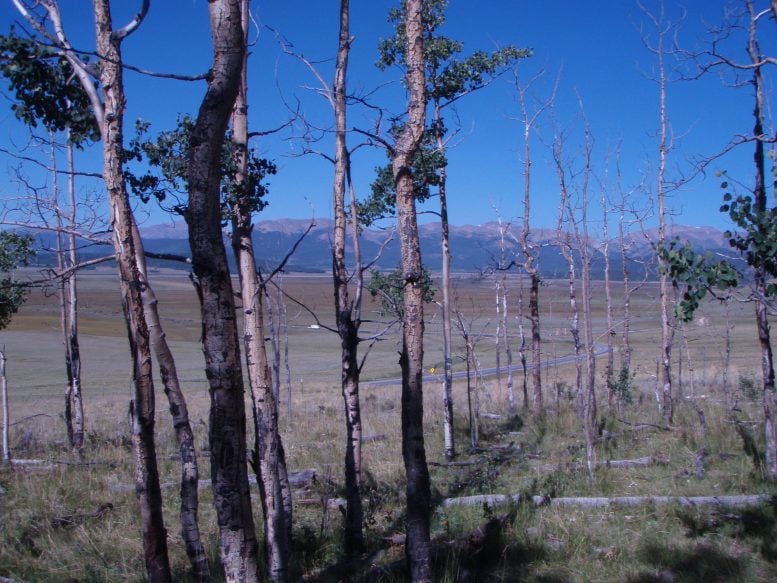Planting a tree appears to be a generally positive thing to do for the environment. After all, trees take in carbon dioxide, offsetting some of the emissions that contribute to climate change.
However, all of that carbon in trees and forests worldwide could be released back into the atmosphere again if the trees burn up in a forest fire. Trees also stop scrubbing carbon dioxide from the air when they die due to drought or insect damage.
According to new research in the journal Ecology Letters, the likelihood of those threats impacting forests is increasing nationwide, making relying on forests to soak up carbon emissions a much riskier prospect.
“U.S. forests could look dramatically different by the end of the century,” says William Anderegg, study lead author and associate professor in the University of Utah School of Biological Sciences. “More severe and frequent fires and disturbances have huge impacts on our landscapes. We are likely to lose forests from some areas in the Western U.S. due to these disturbances, but much of this depends on how quickly we tackle climate change.”
Wildfire, drought, and insects
The researchers modeled the risk of tree death from fire, climate stress (heat and/or drought), and insect damage for forests throughout the United States, projecting how those risks might increase over the course of the 21st century.
See their findings in an interactive map here.
By 2099, the models found, that United States forest fire risks may increase by between four and 14 times, depending on different carbon emissions scenarios. The risks of climate stress-related tree death and insect mortality may roughly double over the same time.
But in those same models, human actions to tackle climate change mattered enormously—reducing the severity of climate change dramatically reduced the fire, drought, and insect-driven forest die-off.
“Climate change is going to supercharge these three big disturbances in the U.S.,” Anderegg says. “We’ve seen devastating fire seasons with increasing severity in the past several years. Generally, we expect the western U.S. to be hit hardest by all three of these. And they’re somewhat interconnected too. Really hot and dry years, driven by climate change, tend to drive lots of fires, climate-driven tree mortality, and insect outbreaks. But we have an opportunity here too. Addressing climate change quickly can help keep our forests and landscapes healthy.”
Reference: “Future climate risks from stress, insects and fire across US forests” by William R. L. Anderegg, Oriana S. Chegwidden, Grayson Badgley, Anna T. Trugman, Danny Cullenward, John T. Abatzoglou, Jeffrey A. Hicke, Jeremy Freeman and Joseph J. Hamman, 11 May 2022, Ecology Letters.,
DOI: 10.1111/ele.14018
The study is published in Ecology Letters and was supported by the National Science Foundation, the U.S. Department of Agriculture, David and Lucille Packard Foundation, and Microsoft’s AI for Earth.










“However, all of that carbon in trees and forests worldwide could be released back into the atmosphere again if the trees burn up in a forest fire.”
Similarly, trees are not immortal and will release their sequestered carbon when they die of old age. It is just a matter of the time scale.
“But in those same models, human actions to tackle climate change mattered enormously …”
Unreliable models that are known to run warm, have contradictory predictions of precipitation at the regional level, and using improbable (SSP5-8.5) scenarios!
During the pandemic lock-downs of early-2020, anthropogenic gas emissions such as methane, nitrous oxides, and lower-troposphere ozone declined, as did their accumulations in the atmosphere. But, NOT carbon dioxide! Anthro’ emissions declined by as much as 18% in April, with an average decline for the year of about 10%. However, the shape and range of the 2020 seasonal CO2 changes are indistinguishable from the previous year, with a net annual gain of about 2.5 PPM, as has been the norm in recent years. That strongly suggests that the natural sources are capable of supplying up to 2.5 PPM/year that are not taken up by the natural sinks, substituting for anthro’ sources, if absent.
Until such time as model ensembles only vary by about 1-5%, there are no longer contradictions at the regional level, and predictions of temperature are within the precision of thermometer measurements (+/-0.05 deg C), researchers should not rely on Earth System Models for predicting secondary effects.
Garbage in, garbage out.